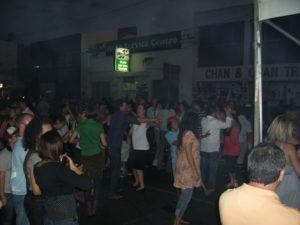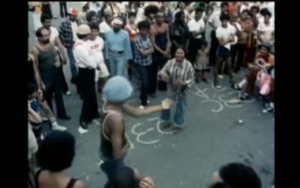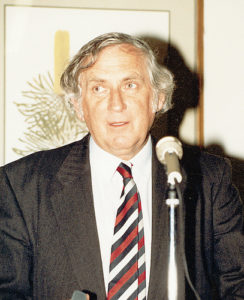Multiculturalism in the 1970s and 1980s takes on a new flavour
This is the third part on Salsa and Latin music in Melbourne, 1970 – 2008. To read about what led up to the events discussed in this blog entry, have a look at the previous post.

The Johnston St. Fiesta in full force, 2007. Australia had an awakening to experience well before we could have events like this.
With a sizeable number of Latin American immigrants…
…the time was ripe for the emergence of certain forms of Latin music, which took root in the country’s cosmopolitan centres such as Melbourne and Sydney. It was not long before Melbourne was hearing Colombian-Caribbean music styles such as the cumbia and mapale with amateur groups such as Sonido Latino leading the new sound.[1] In 1979, future Latin folk music icon Justo Díaz migrated from Argentina, bringing some of the first well-known types of folk music such as the politicized New Song to Australian shores. The same year, Díaz formed the group Papalote.[2]
Melbourne festivals such as Fitzroy’s Johnston Street Fiesta, made official in 1978, and Moomba, in addition to other community and social functions which took place throughout the decade, were hosts to these sounds. These events, despite many of them being part of bigger festivals, tended to be local, small-scale affairs run by and for the various Latino communities.[3]
Unlike the diaspora-associated popularity boom of salsa in other parts of the world at the time, Australia had never received a large influx of Cuban or Puerto Rican immigrants. As a consequence, while people from places like Colombia and El Salvador did play certain styles of Caribbean music, live salsa, with perhaps the exception of recorded music at community events, did not tend to figure prominently in the musical repertoires of such places.

Not Salsa in Melbourne! The Latin Music scene was largely the result of Puerto Rican urban immigration to the Ghettoes of New York, taken from Salsa: Latin Pop Music in the Cities, 1988, dir. Jeremy Marre.
Multiculturalism Unsteadily Creeps in
The second effect of the abolition of the policy was the shift from a discourse of a unified culture, to one of multiculturalism. This change was a gradual process, however, fraught with problems, some of which included an unwillingness to embrace the new political approach. The infamous ‘Great Immigration Debate’, which took place during the Hawke government era, giving us outspoken politicians such as Geoffrey Blainey, had highlighted some of the difficulties and areas of contention with this new political direction. Criticisms on high expenditures on multicultural programs abounded, and the debate had taken on racist overtones, reminiscent of the rhetoric of the ‘yellow peril’.[4]
Even if racist doctrines posed an obstacle to the new approach, who was to say that the idea of ‘race’ had not moved away from its practises based on biological notions of difference, to instead become recoded as ‘culture’, which would see the rise of a newer, more insidious type of racism?’[5] Ho, in a study published in 1990, discusses the ways that in spite of the new ideas regarding multiculturalism, power had still been insidiously kept out of reach from migrant communities by an Anglo-Celtic power base.

Geoffrey Blainey embodied certain anti-immigration sentiment in the 1980s. The road to multiculturalism was not a smooth one. Did we ever get there? credit: http://www.australianoftheyear.org.au/honour-roll/?view=fullView&recipientID=198
The Acceptance of a Multicultural Australia
In spite of such developments, Ho argues that at the turn of the decade, there existed above all, confusion, or a lack of understanding regarding what the new policy actually entailed.[6]
People saw multiculturalism as the new social reality; a reality that was in line with the nation’s interests and ideas about social justice. The proliferation of migrant shops, along with dynamic cultural interactions, had also created a perceived cultural and social enrichment.[7] The end of the 1980s saw that the idea of multiculturalism had, to a degree, helped reconcile the notion of an explicitly racist and isolationist notion of national identity, with one characterised by greater openness and acceptance of cultural diversity.[8] This perceived cultural dynamism and acceptance, in the wake of a transformed Post-Second World War Australia, were the things which were partly responsible for bringing about new possibilities in terms of music. The grounds were now fertile for the spawning of new popular-cultural movements.
Multiculturalism at the end of the 1980s
It was now a buzzword on everybody’s lips, and these years signalled a new epoch of desired cultural interaction, which could be seen reflected in a variety of forms, both in the arts and also in popular culture. In 1988, the Sydney Morning Herald reported on a production of Sounjata, a carnivalesque updating of an African legend. Sounjata related the exploits of a man from a humble background, who after becoming a king, united Western Africa to forge the ancient Mali Empire during the thirteenth century. The play was directed by a Spaniard, and performed by a Swiss with the support of two musicians and actors, one of whom was Chilean, the other Uruguayan.[10] The report stressed the cultural makeup in the performance in a way that would seem odd today, and it was one among many which indicated Australia’s new fascination and curiosity with cultural diversity.
Naturally, many observers saw this in the music scene, with the beginnings of multicultural music events. Event and concert guides which were frequently referred to with regards to multiculturalism graced the pages of Australian newspapers. These papers referred to musicians of Anglo-Australian origin not as musicians, but ‘multicultural musicians’.[11]
Conclusion
So that concludes our look at some of the dimensions of multiculturalism in the 1970s and 1980s, and we’re probably halfway. Next we look at the arrival of salsa itself on the music scene. Who were the biggest proponents of the sound? Who was the market? Read on about the journey of Salsa and Latin music in Melbourne…
